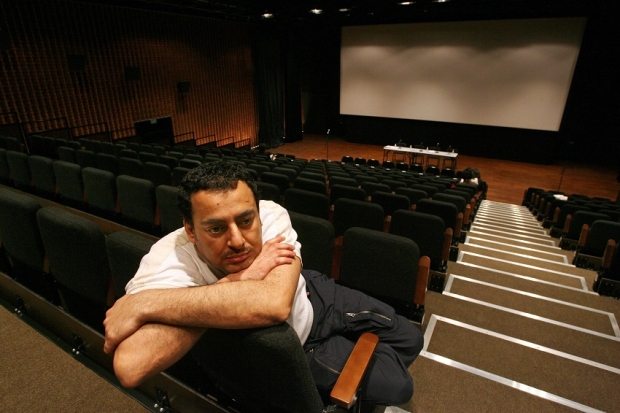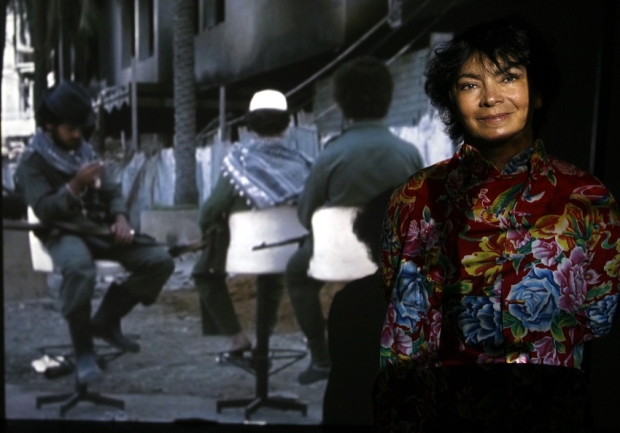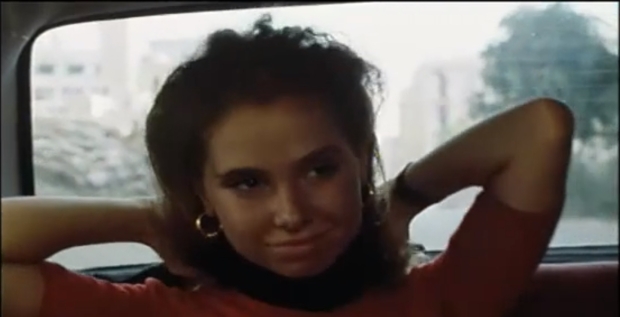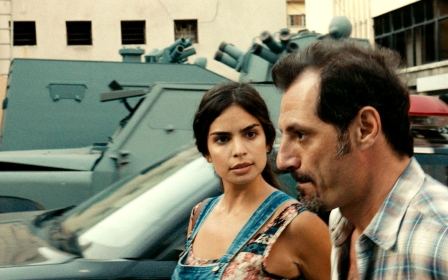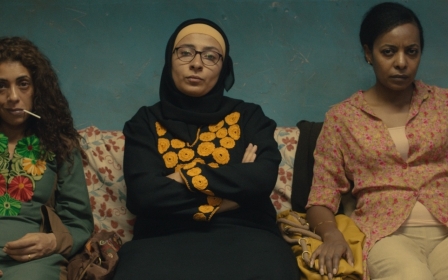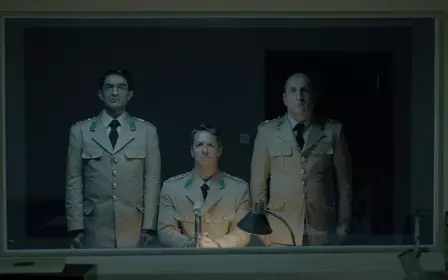A tale of two film mavericks: Jocelyne Saab and Oussama Fawzi

LOS ANGELES, USA - The story of Arab cinema is partially defined by unfulfilled potentials, thwarted ambitions and amputated careers. Scorching talents, aesthetical innovation and defiant politics have also been overlooked time and time again.
The stories of Jocelyne Saab, a Lebanese journalist, artist and filmmaker, and Egyptian director Oussama Fawzi are no different. The two celebrated film auteurs passed away on 7 January and 9 January, respectively, aged 70 and 58, leaving behind a small body of work that ranks among the most singular in modern Arab cinema.
I met Saab for the first time in 2014 in Cairo while she was researching for a musical project set in the early years of Egyptian cinema. And my correspondence with Fawzi was strictly viral, when I programmed his film, Fallen Angels Paradise (1999) last September at the Safar Film Festival in London for its long-delayed UK premiere.
New MEE newsletter: Jerusalem Dispatch
Sign up to get the latest insights and analysis on Israel-Palestine, alongside Turkey Unpacked and other MEE newsletters
Their cinematic oeuvres appear to share little resemblance, but on closer inspection, similarities begin to arise.
Both presented atypical, confrontational portraits of their home countries. Both only had four feature films to their names, wore their liberal politics on their sleeves and adopted atypical narrative frameworks. Both were never given due recognition internationally and struggled to find financing for their projects.
Their films deviated from convention, combining raw realism with surrealism while shattering stereotypical representations of their nations.
Jocelyne Saab: The reality of Beirut
Born in 1948 in Beirut, Saab studied economics in Paris before moving to journalism and subsequently documentary film-making with the outbreak of the Lebanese civil war in 1975.
Her directorial debut, Lebanon in a Whirlwind (1975), was a valiant and ultimately futile attempt to make sense of the senseless - the then-unfolding conflict.
Interviewing the likes of Druze leader Kamal Jumblatt, and Christian Phalangist party founder Pierre Gemayel, Lebanon in a Whirlwind provided a preview of Saab’s faculties, namely a firm command of the material, a remarkable even-handedness and a notably calm tonality.
Her subsequent non-fiction work would see her directing her lens to the unfolding destruction of her hometown. In her Beirut trilogy - Beirut, Never More (1976), A Letter from Beirut (1979) and Beirut, My City (1982), Saab began her career-long quest of probing the individual’s relationship with their cities, including their fictitious histories, their uncertain present and their profound psychological impact.
In their evocation of loss, memory and identity, Saab’s work has often been compared to French filmmaker Alain Resnais, whose films explored the subjectivity of individual memory and the distorting impact of war on it.
Saab’s early work was typified by one central internal conflict and a journalistic determination to expose the city unadorned. Her films encompassed a nostalgic desire to recreate the fantastical place of her childhood: between the whimsical, unreal past, and the ugly, tangible present.
This tendency would continue to inform her other city portraits, particularly Cairo and her short documentary, Egypt City of the Dead (1978).
The move to fiction
In 1985, Saab made her narrative fiction debut with A Suspended Life, a bittersweet tale about a budding friendship between a teenage girl from the south of Lebanon and an artist from west Beirut.
The schism between the real and the imagined is front and centre. It is depicted in the contrast of the girl’s fixation on the wonderlands of Egyptian cinema and the overriding destruction around her. And, off-camera, in Saab’s yearning for reconciliation among the squabbling sects, and the gory, hostile reality on the ground.
It would take Saab another 10 years to produce her sophomore effort, Once Upon a Time, Beirut (1995), which was also her first feature after the end of the 15-year war.
A girl (Michèle Tyan), celebrating her 20th birthday, takes her best friend (Myrna Maakaron) to visit a mysterious old film collector, Emile Accar, and asks him to show them his Beirut - the Beirut they never know. Fact and fiction blur as the two struggle to distinguish the mythical from the real.
Saab has been erroneously dubbed as the great chronicler of lost Lebanese memory. Memory is certainly one of her crucial preoccupations: the personal, the collective and the imagined. Saab’s notion of memory is Proustian: slippery, unreliable and transient.
Yet what Once Upon a Time, Beirut ultimately does is question the myths behind these memories, be they historical, sectarian or filmic.
The great Beirut propagated by the movies of the 1960s, of being the liberal, prosperous, cosmopolitan Switzerland of the East, may have been nothing but a figment of the Arab imagination – a shiny facade concealing the odium, aggression and the moral bankruptcy that would explode with the civil war.
This was all done in a largely plotless narrative conceived with a witty, unruly and inventive visual style that demonstrated a confident craftswoman exploring the limitless possibilities of what cinema can do.
Once Upon a Time, Beirut remains one of the most novel, most affecting Arab films of the 1990s, and Saab’s unrivalled masterwork.
Candid feminism
Ten more years would pass before Saab directed another narrative fiction, the Sundance entry Dunia (2005), an Egyptian musical about a twentysomething literature student, played by Hanan Turk, who is aspiring to be a dancer.
Drawing inspiration from 1001 Nights, Arabic poetry and Egyptian classical melodramas, Dunia was Saab’s most candid feminist statement: an attack on patriarchy and socio-religious traditions and a cry for self-emancipation and self-actualisation.
Handled with sensitivity and earnestness, it was, nonetheless, met by hostile and critical reaction in Egypt, particularly for its handling of genital mutilation in one plotline, along with its deliberately disjointed narration.
The same disjointed narrative would be adopted in Saab’s fourth feature, What’s Going On? (2009), a surreal fable set in Beirut about a writer and a dressmaker (played by celebrated author, Jalal Khoury) who encounters three different women who teach him different lessons about women, love and life.
All the women, in one way or another, are different manifestations of Beirut, each representing a different identity of the city.
Oussama Fawzi: A stark view of Cairo
While Saab’s fondness and, occasionally, naïve belief in Beirut offset the reality she didn’t shy away from tackling, there was nothing remotely bright to temper Oussama Fawzy’s stark vision of Cairo, his home city.
Born in 1961, his father was Girgis Fawzy, a prominent producer. Fawzi cut his teeth on film as an assistant director to notable directors including Yousry Nasrallah, Radwan El-Kashef, and Ra’fat El Meehy.
Oussama made his directorial debut with the Locarno Film Festival competition entry, Afarit el-asphalt (Phantoms of the Road, 1996), a medium-sized production about a group of bus drivers navigating their way in a decaying post-socialist Cairo.
Weaving an intricate web of relationships delineated by power struggles and sexual infidelities, Fawzi’s world was a far cry from the morally conservative neo-realist Egyptian films of the 1980s. His films cast an intense non-judgmental eye on a godless working-class world governed by stifled dreams, raging libidos and acceptance of a reality that would not change.
The mix of the surreal with the real in Fawzi’s movies are rooted in the works of Italian maestro Federico Fellini, and Spanish provocateur Luis Buñuel, while his liberal politics owes a great debt to the films of fellow countryman, Yousry Nasrallah.
Like Saab, Fawzi had a knack for seamlessly mixing the bizarre with the real. More than Saab, however, he constantly revelled in the fundamental act of storytelling, searching for meaning in a meaningless time and place.
Fallen angels, rising stars
Fawzi would delve further into the metaphysical in 1999 with his next feature, Ganet al-shayateen (Fallen Angels Paradise) which also competed at Locarno. Based on a short story by Brazilian writer Jorge Amado, the black comedy centres on a middle-aged hoodlum (played by frequent collaborator, Mahmoud Hemeida) who suddenly dies of a heart attack.
His young thug brethren find out that he was once the respected head of a Coptic Christian family and embark on a nocturnal journey to deliver his corpse, while suspecting that he may not be dead after all.
One of the most original and audacious Egyptian productions of the 1990s, Fallen Angels Paradise made little money at the local box-office but would later become a cult hit, establishing Fawzi as one of the most unique talents in contemporary Egyptian cinema.
It was, after all, fronted by a dead protagonist and contained no traditionally sympathetic characters. It also starred a number of young actors, including Amr Waked, who later starred in Syriana (2005) opposite George Clooney, and Lucy (2014) with Scarlett Johansson.
The shock of the new
Fallen Angels Paradise was unlike anything that had been seen before in Egyptian cinema at the time, and 20 years after its release it still retains the power to shock, provoke and astonish.
It remains Fawzi’s darkest film, a frenzied journey into the abyss of the human soul which shrewdly explores the elusive nature of death, the taxing weight of choice and the indefinable parameters of morality.
Above all, it is about class and the expanding division between the shackling privileges of the bourgeoisie and the forebodingly limitless freedoms of the outlaws.
Concluding with an orgy in a car, Fallen Angels Paradise ultimately unfolds into a colossal celebration of transgression: another Egyptian underworld where lust, fraternity and sheer instinct for survival trump any religious or social code.
The film was also distinct for being among the rare pictures to feature a Christian protagonist. Fawzi would go one step further in 2004 with Baheb el-cima (I Love Cinema), the biggest commercial hit of his career and his most controversial work.
The film is a semi-autobiographical story of a young boy (Youssef Othman) finding respite in cinema from his ultra-religious orthodox father in the waning days of the Gamal Abdel Nasser era.
It remains the only Egyptian film to highlight, explore and criticise Christian orthodox doctrine, with an unfaltering depiction of Orthodox rituals and lifestyle. Not surprisingly it incited the ire of the Coptic church, propelling lawyers to file lawsuits that accused Fawzi – a former Christian who converted to Islam – of insulting Christian doctrine.
It was also Fawzi’s most political work, acting as an exorcism of his childhood demons and as a confrontation with the political and religious dogma that he grew to rebel against.
The father’s extreme religiosity is depicted as a by-product of Egypt’s larger authoritarian political climate – another form of control passed on by a generation that dare not think, question, or protest.
Taking a leaf out of Swedish director Ingmar Bergman’s playbook, the father’s questioning of the silence of God was the first instance in Egyptian cinema where doubt over the benevolence, even the existence of God, was expressed so explicitly.
Tool of resistance
Cinema, in Fawzi’s world, functions not only as a vehicle of escapism but as a tool of resistance. The same goes with sex and art: two interlinked modes of expressions that offer a glimpse of freedom from the tyrannical family structure – an institution disparaged in all of Fawzi’s work.
Art takes centre stage in Fawzi’s last feature, Bel alwan al-tabeaya (In True Colors, 2009), a colourful inspection of visual art in an increasingly religious society torn between its secular past and conservative present.
The art student lead, Karim Kasem, attempts to reconcile his confused and stifling religious beliefs and the freedoms ingrained in the act of creation.
More than his previous films, In True Colours contains the most blatant indictment of the Mubarak age, an era where everything – religion, art, knowledge – has been institutionalised; where everything has been robbed of its essence and where everything has been compartmentalised, privatised and deformed.
The Western viewer becomes a major factor in the filmic equation. In the worst instances, the director-as-guide is suddenly conducting an audience of tourists through of his culture
- Jocelyne Saab
Both Oussama Fawzi and Jocelyne Saab were passionate, resilient and strangely defiant. Each was sidelined and marginalised by their respective industries. They were also too radical and insubordinate for their societies and punished for adhering to their idiosyncratic form of art-making.
Saab, who relied mostly on French money to bankroll her movies, was forced to comply to the demands of the French, especially in the usage of French dialogue. “When I get financing of five million francs from France, I run the risk of having to change my scenario,” she explained in 1989. “Not always, but frequent enough, changes are made. The Western viewer becomes a major factor in the filmic equation. In the worst instances, the director-as-guide is suddenly conducting an audience of tourists through of his culture.”
Fawzi, on the other hand, had to apply for Cairo International Film Festival’s Cairo Connection co-production platform last November, and pitch his project, like young filmmakers, to foreign producers after failing to find producers at home willing to back his new endeavour.
While their work shall inspire generations to come, it may also transpire as a cautionary tale about the heavy price Arab filmmakers must pay to fully realise their visions.
Middle East Eye delivers independent and unrivalled coverage and analysis of the Middle East, North Africa and beyond. To learn more about republishing this content and the associated fees, please fill out this form. More about MEE can be found here.


